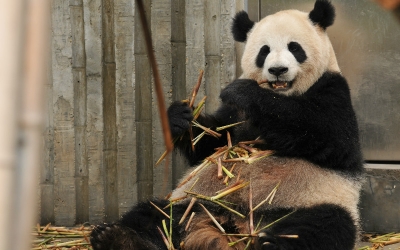
The giant panda’s distinct black-and-white markings have two functions: camouflage and communication. Most of the panda – its face, neck, belly, rump – is white to help it hide in snowy habitats. The arms and legs are black, helping it to hide in shade. Mother pandas keep contact with their cub nearly 100% of the time during their first month – with the cub resting on her front and remaining covered by her paw, arm or head.
At 5 months old, giant pandas learn how to climb – sometimes practicing by climbing on their mum. They have an extended wrist bone that they use like a thumb to help them grip food. They have an extended wrist bone that they use like a thumb to help them grip food. Pandas need at least 2 different bamboo species in their range to avoid starvation
Although pandas are 99% vegetarian their digestive system is typical of a carnivore. For the 1% of their diet that isn’t bamboo, pandas eat eggs, small animals, carrion, and forage in farmland for pumpkin, kidney beans, wheat and domestic pig food. Sometimes, to mark their scent, panda’s climb a tree backwards with their hindfeet until they’re in a full handstand upside down – enabling them to leave their scent higher up. On average, pandas poo 40 times a day.
Credit : World Wildlife Fund
Picture Credit : Google




